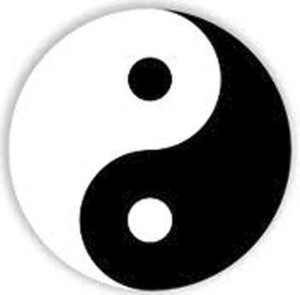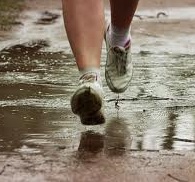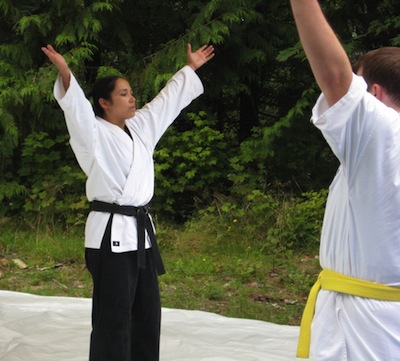Taichi Jiu-jitsu? Exploring the Commonalities between Martial Arts
 What do Taichi and Jiu-jitsu have in common? No, this isn’t a joke and no, I’m not crazy. When you look past the surface images of elderly people doing slow-moving patterns, there are many fundamentals that are alike. And not just with Jiu-jitsu, but many other martial arts styles as well, as many students discovered at the Pacific Association of Women Martial Artists camp I recently attended. At one of the classes I took when I attended this year’s PAWMA camp, Sifu Debbie Leung, instructor at Chinese Healing & Movement Arts, related some of the fundamental principles guiding the practice of Taichi (a.k.a.- Taiji). She didn’t simply teach us a pattern from her style. She had all the students choose a particular sequence from their styles then we applied each Taichi principle to that move.
What do Taichi and Jiu-jitsu have in common? No, this isn’t a joke and no, I’m not crazy. When you look past the surface images of elderly people doing slow-moving patterns, there are many fundamentals that are alike. And not just with Jiu-jitsu, but many other martial arts styles as well, as many students discovered at the Pacific Association of Women Martial Artists camp I recently attended. At one of the classes I took when I attended this year’s PAWMA camp, Sifu Debbie Leung, instructor at Chinese Healing & Movement Arts, related some of the fundamental principles guiding the practice of Taichi (a.k.a.- Taiji). She didn’t simply teach us a pattern from her style. She had all the students choose a particular sequence from their styles then we applied each Taichi principle to that move.
When it comes to seminars, this type of format in which the instructor teaches concepts from their style in ways that are applicable for a variety of styles, is one I love. This makes the concepts more relevant the students’ own styles, allowing the students to take that concept home and continue using what they learned. I usually try to teach principle-based seminars myself as described in my blog post, My Approach to Teaching Martial Arts Seminars. (more…)
How to Run in the Rain (or Do Anything Else that Requires Motivation)
 Most of you know that I am a regular runner and that I live in the mild, wet climate of Vancouver, BC on Canada’s west coast. We have amazing summer weather that isn’t blisteringly hot and/or humid as it
Most of you know that I am a regular runner and that I live in the mild, wet climate of Vancouver, BC on Canada’s west coast. We have amazing summer weather that isn’t blisteringly hot and/or humid as it
is in the vast majority of the country. The rest of the year is also warmer than the rest of the country, and we get almost no snow, but it’s wet, wet, wet! It’s not that our weather makes running prohibitive, but it does take a little more commitment to keep your running schedule going in the face of pelting rain. (more…)
On Being in the Public Eye
 Putting yourself in the public eye, whether it’s as a sports competitor, martial arts instructor, writer, actor, film producer, etc, is a bold move for any person. What you create or impart is a representation of who you are, your knowledge, talent, efforts, and skills. The more people you touch, the bigger your potential impact on the world around you. Being in the public eye puts you in a position where you can have great power, but simultaneously puts you in a position of great vulnerability. For people to see you, you have to rise above the crowds. In doing so, it makes it easier for them to throw rocks. (more…)
Putting yourself in the public eye, whether it’s as a sports competitor, martial arts instructor, writer, actor, film producer, etc, is a bold move for any person. What you create or impart is a representation of who you are, your knowledge, talent, efforts, and skills. The more people you touch, the bigger your potential impact on the world around you. Being in the public eye puts you in a position where you can have great power, but simultaneously puts you in a position of great vulnerability. For people to see you, you have to rise above the crowds. In doing so, it makes it easier for them to throw rocks. (more…)
5 Things I Learned about Fighting from Captain Kirk
 Some of you may already know this, but I am a sci-fi geek. I am a big fan of Star Trek and have thoroughly enjoyed J.J. Abrams’s alternative reality, modernized version of the original series with Captain Kirk, Mr. Spock and all the characters that made that show. While I won’t engage in arguments over which Star Trek captain was best, I do have a soft spot for Kirk’s fighting spirit, and have found myself citing examples from Star Trek to illustrate certain points. This article delves into this more deeply. *SPOILER WARNING: If you haven’t seen the first new re-make of Star Trek and want to see it fresh, don’t read this article until after you’ve seen it.
Some of you may already know this, but I am a sci-fi geek. I am a big fan of Star Trek and have thoroughly enjoyed J.J. Abrams’s alternative reality, modernized version of the original series with Captain Kirk, Mr. Spock and all the characters that made that show. While I won’t engage in arguments over which Star Trek captain was best, I do have a soft spot for Kirk’s fighting spirit, and have found myself citing examples from Star Trek to illustrate certain points. This article delves into this more deeply. *SPOILER WARNING: If you haven’t seen the first new re-make of Star Trek and want to see it fresh, don’t read this article until after you’ve seen it.
Your One Core Value & How It Defines Your Life
 Everyone has their own personal values, but if I were to ask you right now what your one core value is that relates to all your other values, would you be able to give an easy answer? By knowing what your one core value is helps makes sense of why you do the things you do and react to people and situations in certain ways. It is a personal insight that can help you overcome the struggles you face so you can more fully embrace your strengths.
Everyone has their own personal values, but if I were to ask you right now what your one core value is that relates to all your other values, would you be able to give an easy answer? By knowing what your one core value is helps makes sense of why you do the things you do and react to people and situations in certain ways. It is a personal insight that can help you overcome the struggles you face so you can more fully embrace your strengths.
Discovering Your One Core Value
Life starts with our childhood years. The experiences we have during those years strongly influence the way we look at the world. That is why when we experience trauma when we’re young, it continues to affect our world view long into adulthood. Pretty much everyone experiences something that is personally traumatic to them at a young age, producing some sort of fear that influences their actions thereafter. As we gain more experience in life, we may undergo more experiences that continue to support that fear. Alternatively, we may develop positive coping measures that help us move past that fear. Either way, that fear shapes our one core value that influences all the other values we develop in our lives. (more…)
How to Move Past Excuses and Start Living the Life You Choose
 Want to get more exercise? Eat healthier? Learn a new skill? Write a book? Get a better job? Start a business? Travel to a India? Cut back on booze? Quit smoking? For every personal goal there is a litany of excuses:
Want to get more exercise? Eat healthier? Learn a new skill? Write a book? Get a better job? Start a business? Travel to a India? Cut back on booze? Quit smoking? For every personal goal there is a litany of excuses:
“I’m too busy.”
“I can’t afford it.”
“I have family and/or career commitments.”
“I’m too old/too young.”
“I’m just too —-. It’s just the way I am.”
“It’s just too hard.”
“I’m not strong/capable/disciplined enough.”
These are the tales of woe we tell when we aren’t doing the things we say we want to do. They are stories. Every one has a story, but every story has different angles. There is one simple solution to living life as a victim of circumstance. (more…)
Finding the Opportunity in Each Crisis in the Martial Arts
 A couple of weeks ago I had my students working on quick wrist escapes in class. The goal is to slip out of wrist grips by engaging their bodies from the hips then directing their trapped wrist through the weakest part of the grip. The action I was teaching is used against a wrist grab from the front in which the thumb is at the top of the grip.
A couple of weeks ago I had my students working on quick wrist escapes in class. The goal is to slip out of wrist grips by engaging their bodies from the hips then directing their trapped wrist through the weakest part of the grip. The action I was teaching is used against a wrist grab from the front in which the thumb is at the top of the grip.
While the students were training, Chris, the other instructor assisting on the mats came over and asked me to grab his wrist so he could practice it a few times himself. After he got to do it a few times, he went and grabbed my left wrist, but grabbed with the thumb down rather than up. As I initiate the action of the technique, I realized the grip was different mid-movement as I met the force of the strong part of the grip rather than the thumb and forefingers that would usually result in a quick escape. As I sensed the resistance, I reached under his wrist, clasped my hands together, then reversed my hip turning into him, putting him in a type of wrist lock using his fingers to apply the pressure. (more…)
Focusing on Advantage & Opportunity Over Weakness & Liability
Smaller statured men and women often encounter many challenges in the martial arts related to their smaller strength, weight, height and reach. More often than not, they frustratedly struggle against their limitations, which frequently leads to their giving up early on in their career. Or if they stick with it, they sometimes settle for less with themselves, accepting that there are some things they will simply never be able to do well in the martial arts. This is what happens when you focus on your weaknesses and the liabilities they present. Over the past 20 years of training as a smaller statured woman, I’ve learned that the best way to compensate for so-called liabilities is to focus on developing my personal strengths and the unique opportunities they present. (more…)
No Do-overs: The Benefits of Training through Your Mistakes
 Having taught martial arts for nearly two decades, you come to notice certain learning habits people have that come from societal influences. For example, in Western society, people have don’t feel comfortable “failing” at something. When they attempt to do something, they want to do it as close to perfection as possible, which influences the way they practice a skill.
Having taught martial arts for nearly two decades, you come to notice certain learning habits people have that come from societal influences. For example, in Western society, people have don’t feel comfortable “failing” at something. When they attempt to do something, they want to do it as close to perfection as possible, which influences the way they practice a skill.
In Jiu-jitsu, some will start a technique then stop half-way through as they realize they’re not getting it quite right. If I let the student keep doing this, it would be entirely possible to see that student stop and re-start a technique over and and over without actually getting through it once before the class is called to see the next technique. Another way the unwillingness to fail can manifest is when a student either asks lots of detailed questions, or spends a lot of time talking about it, analyzing how it’s supposed to work, etc. These types will spend so much more time talking about it, fooling themselves into thinking that simply talking about it will make them better at it, that they don’t spend as much time practicing it. These types strategies for avoiding looking foolish or “failing” at a technique can hurt one’s mentality towards self-defense, as well as one’s development as a martial artist. (more…)
Jiu-jitsu Sensei’s Top 10 Posts on Development in the Martial Arts
 If you read our blog regularly, you probably know that we are strong proponents of personal development in and through the martial arts. Learning self-defense and getting/staying fit are the main reasons most students join us, but the ones that stay over the long term usually find other less obvious benefits that seep into them over time through their training. Today, we’re going to feature the top 10 articles related to personal development in and through the martial arts in the history of our site. Here they are below. Enjoy!
If you read our blog regularly, you probably know that we are strong proponents of personal development in and through the martial arts. Learning self-defense and getting/staying fit are the main reasons most students join us, but the ones that stay over the long term usually find other less obvious benefits that seep into them over time through their training. Today, we’re going to feature the top 10 articles related to personal development in and through the martial arts in the history of our site. Here they are below. Enjoy!
1. 3 Methods for Learning Martial Arts More Efficiently and Effectively.
2. Black Belt is Where the Real Learning Begins: Putting the Saying into Practice. (more…)

 We're proud to announce that Lori O'Connell Sensei's new book, When the Fight Goes to the Ground: Jiu-jitsu Strategies & Tactics for Self-Defense, published through international martial arts publisher Tuttle Publishing, is now available in major book stores and online. More about it & where to buy it.
We're proud to announce that Lori O'Connell Sensei's new book, When the Fight Goes to the Ground: Jiu-jitsu Strategies & Tactics for Self-Defense, published through international martial arts publisher Tuttle Publishing, is now available in major book stores and online. More about it & where to buy it.